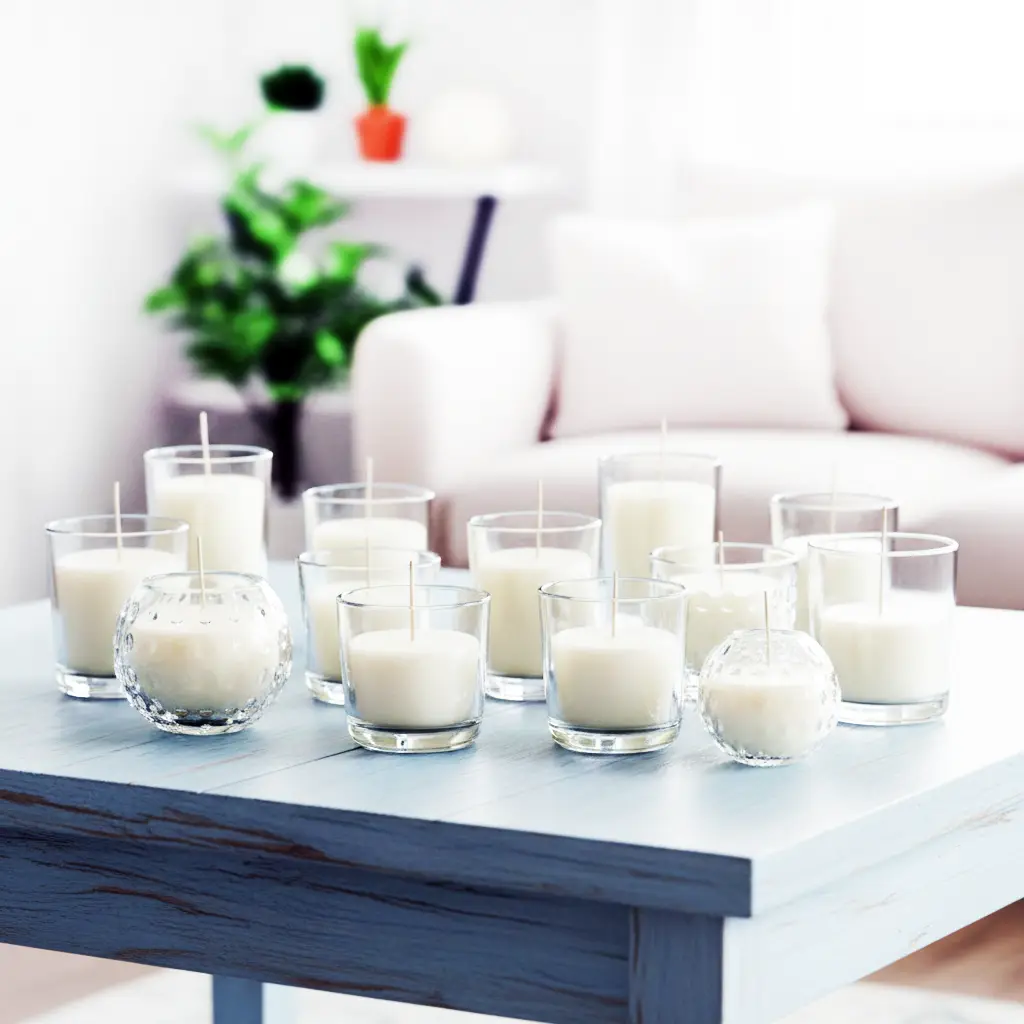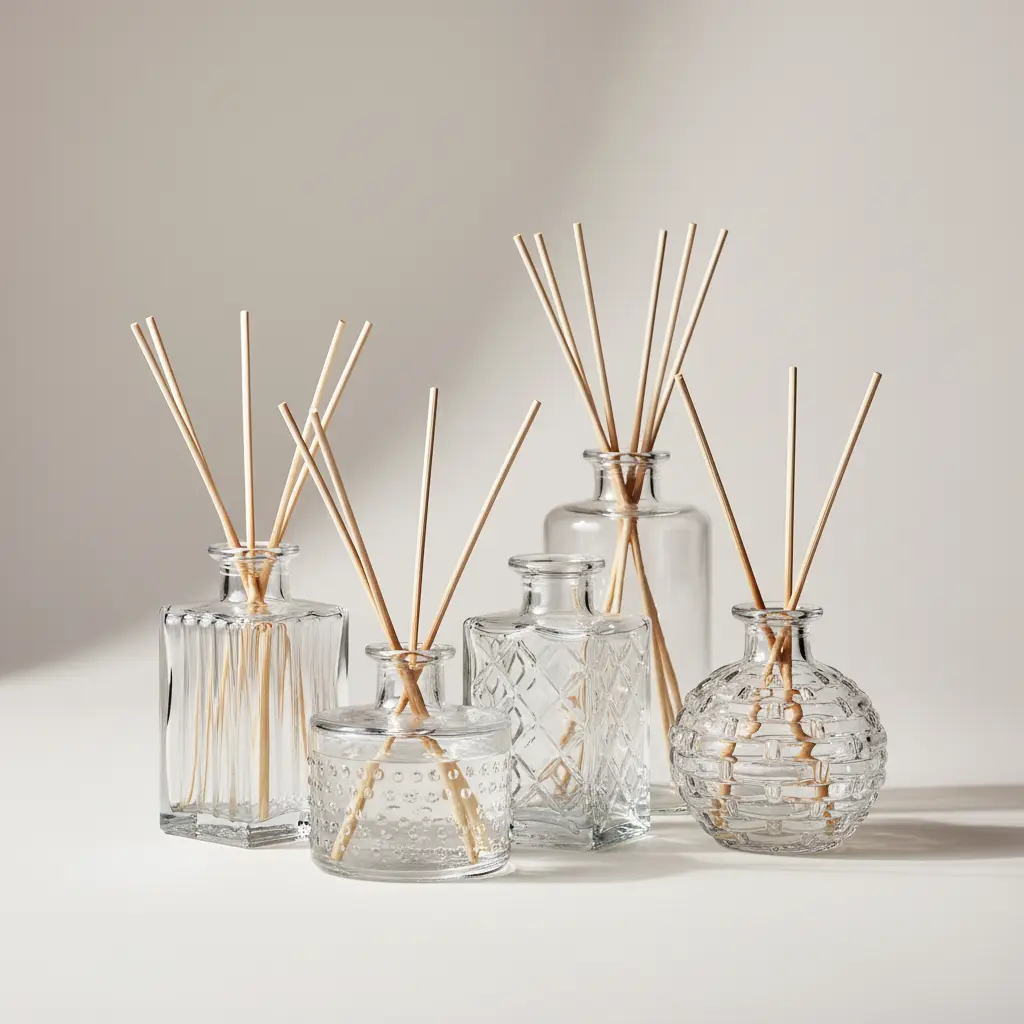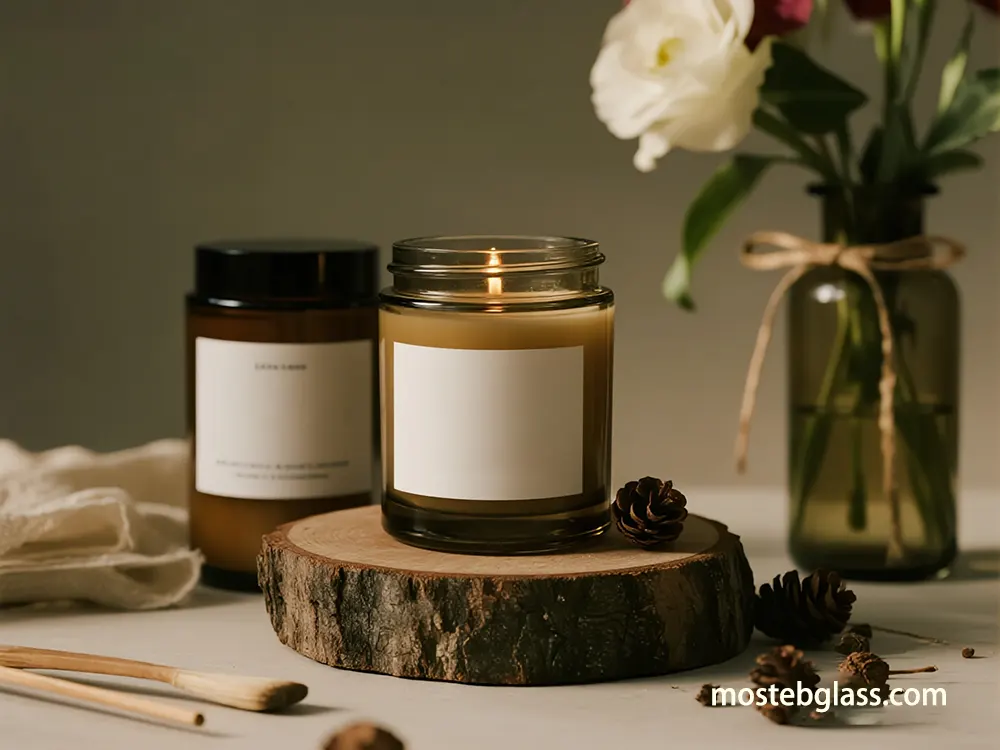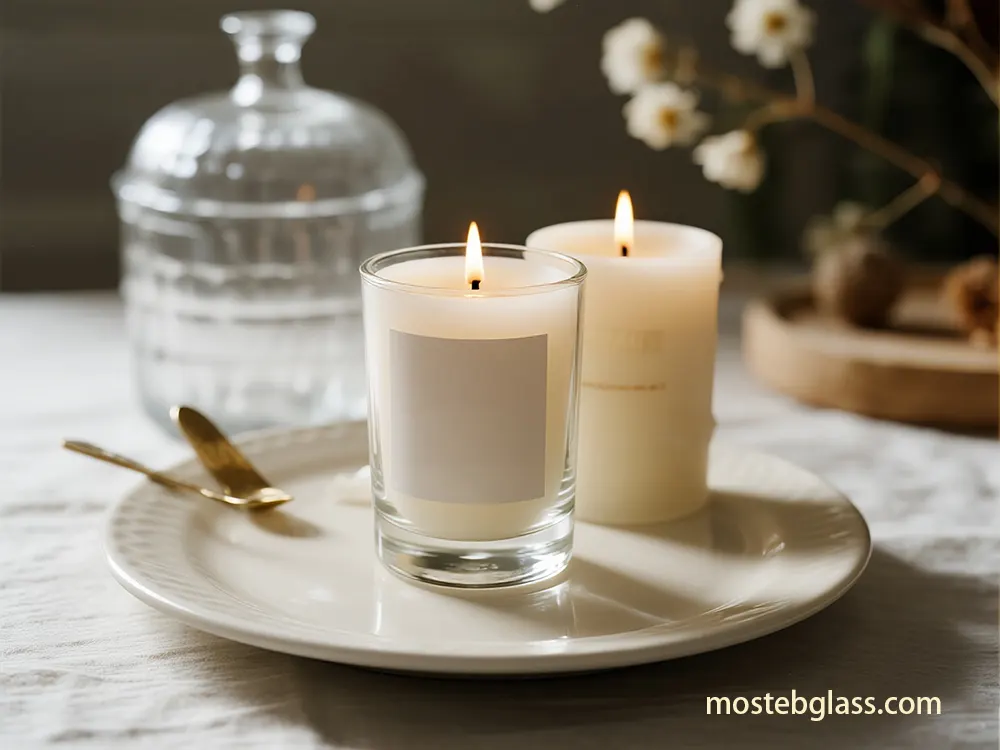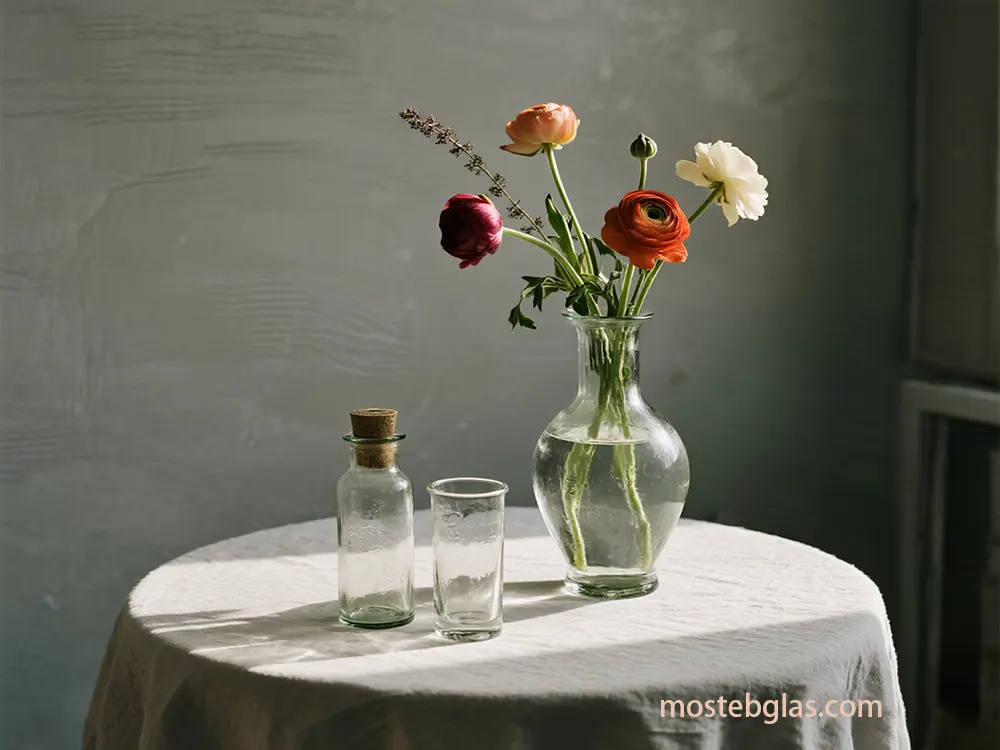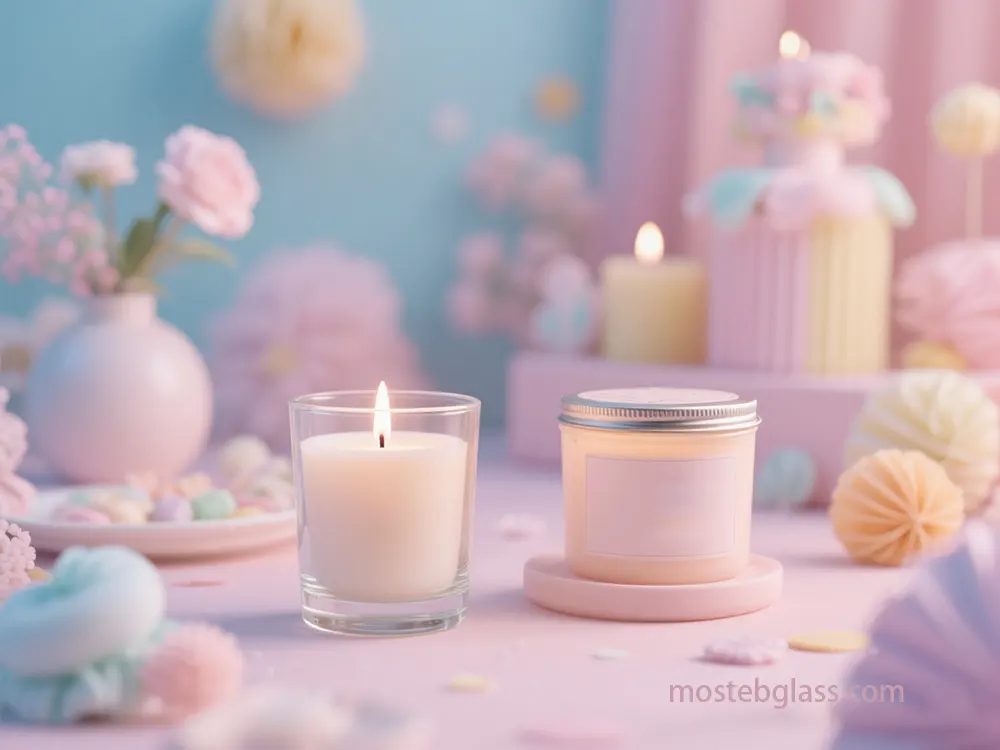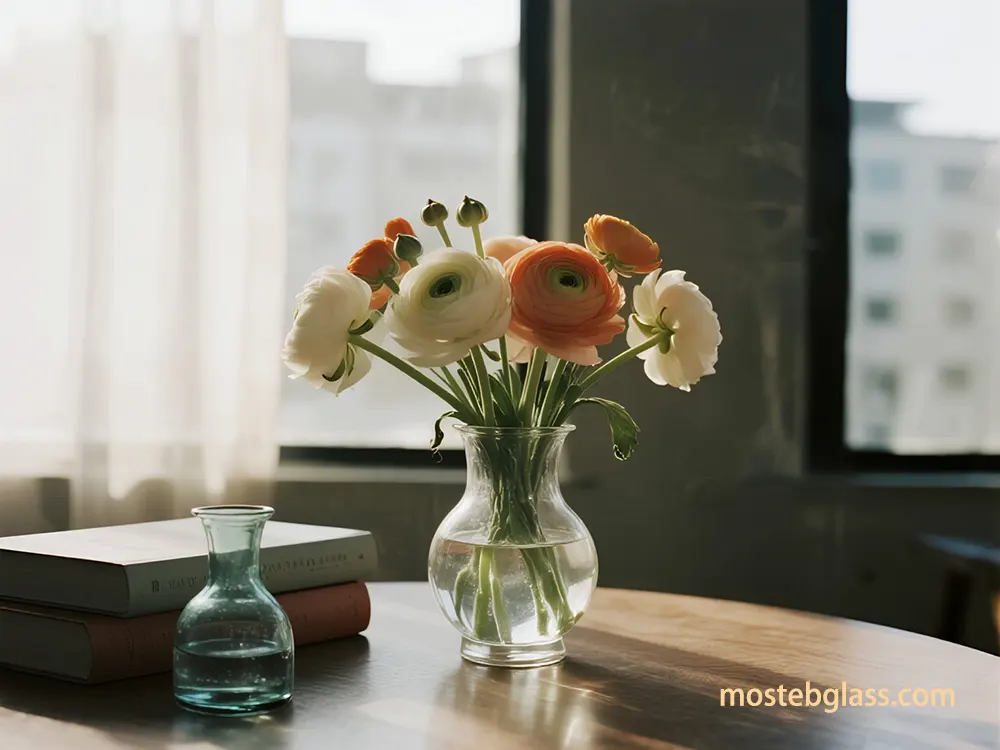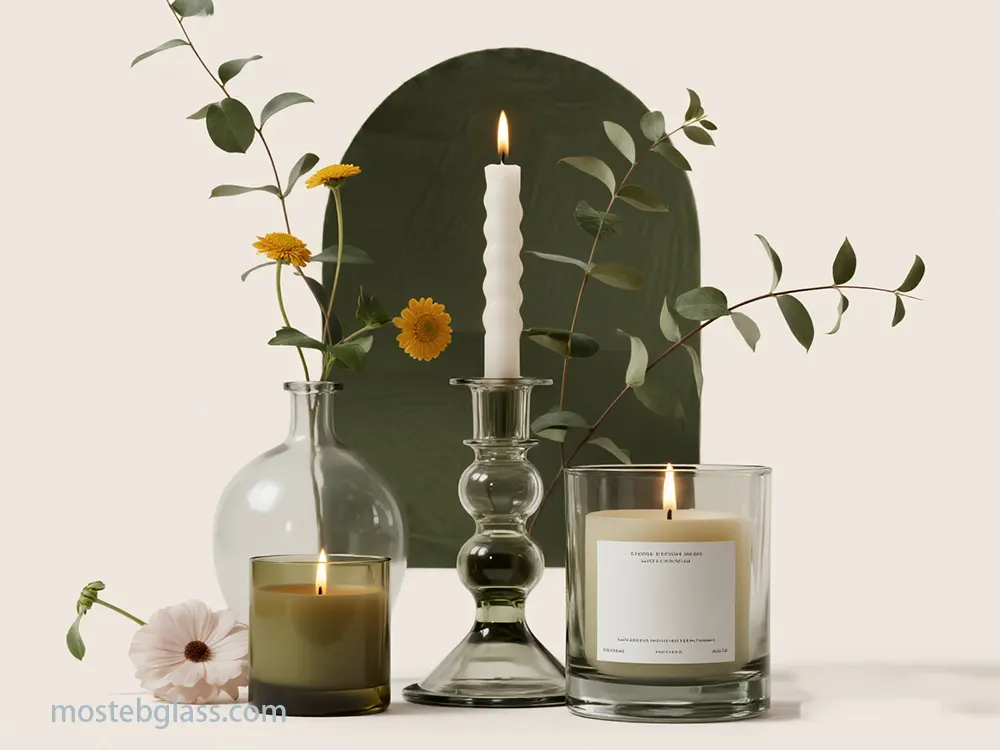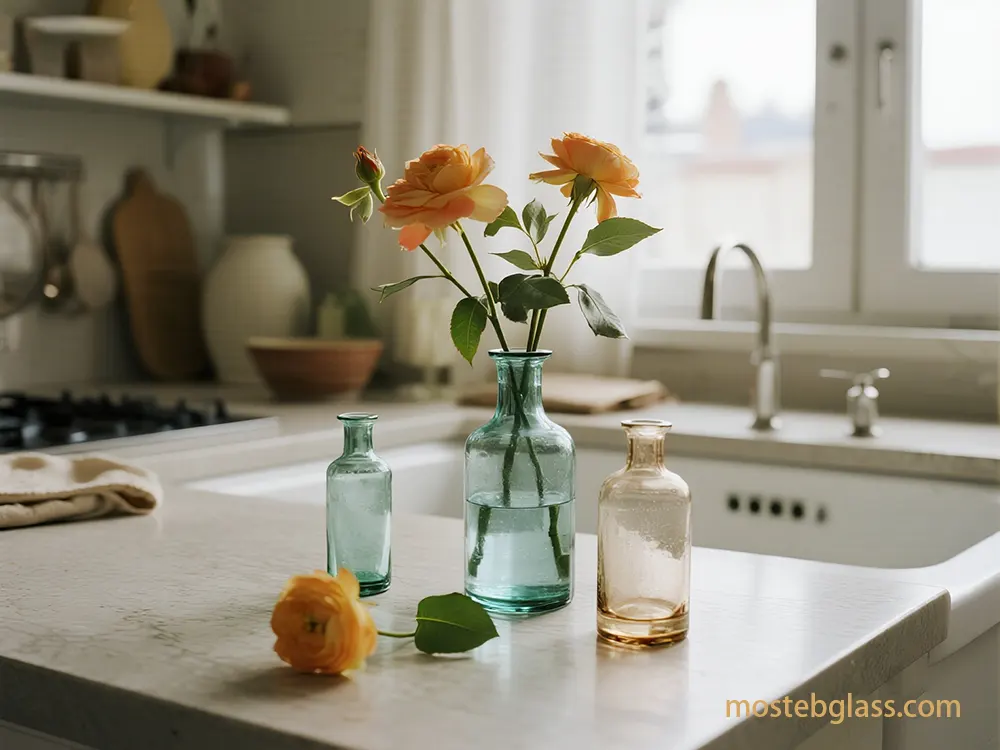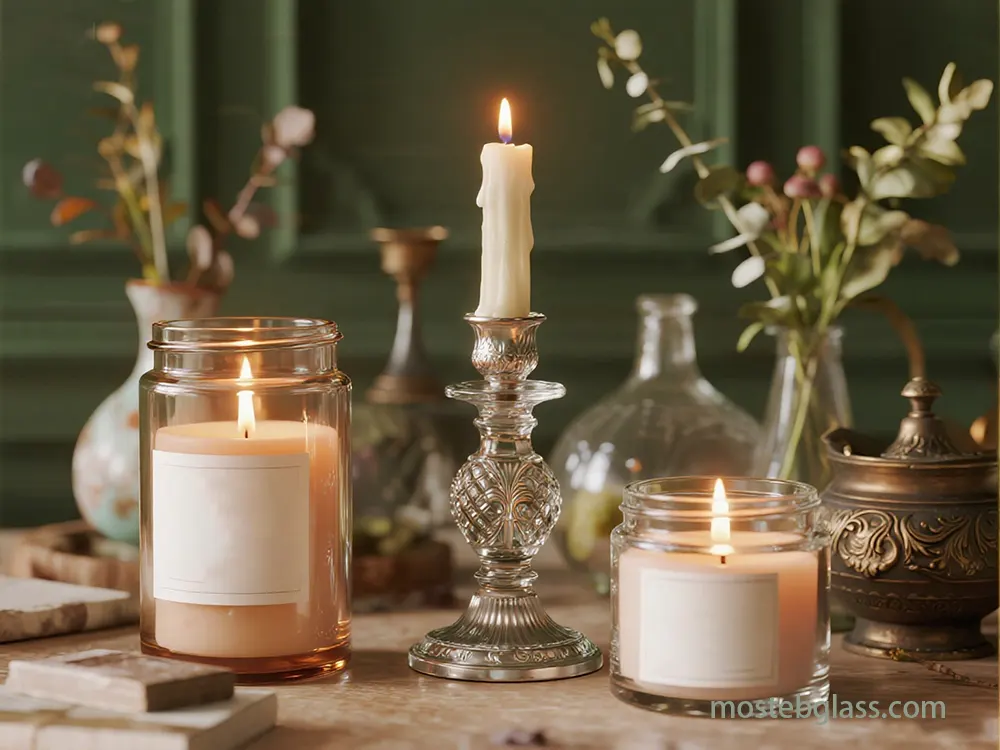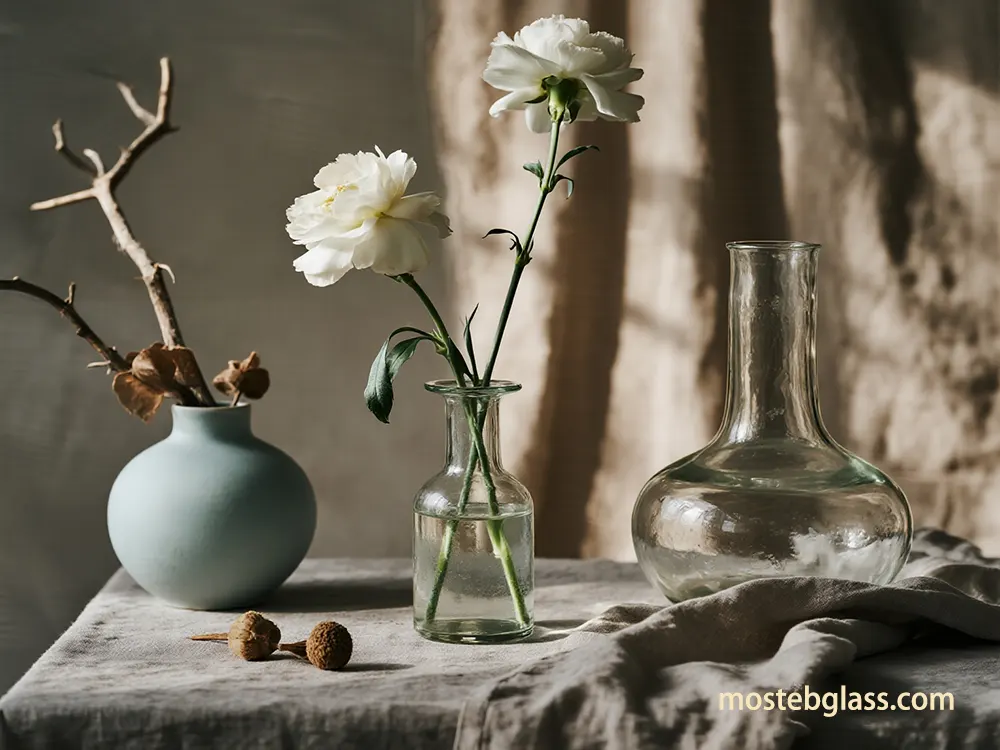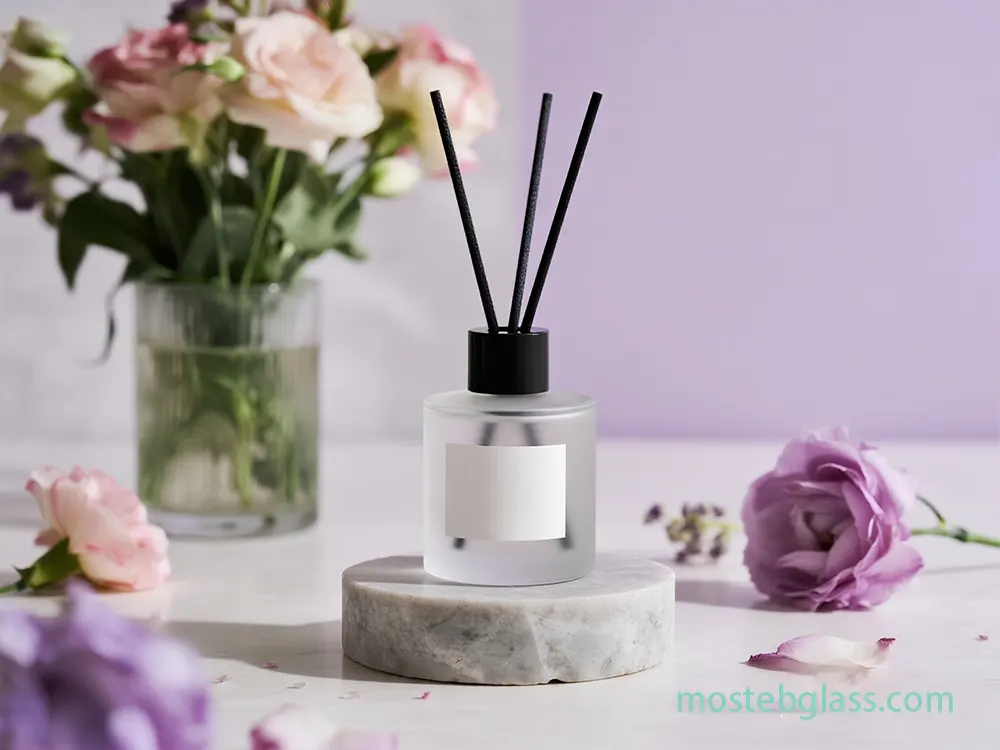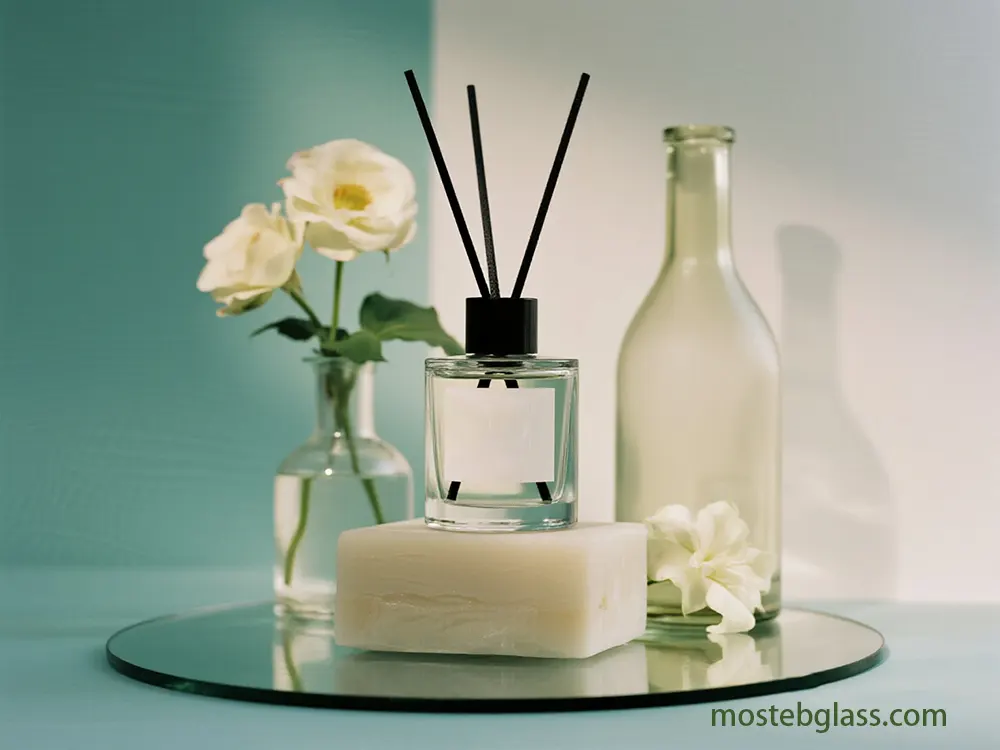2.8. Mirrored Glass for Spatial Illusion, Product Highlight, and Customer Interaction
Mirrors reflect light and images, create confusion of vastness and provide extra lights. The mirror advertising display combines a mirror with a hidden screen, when the material shows and when a mirror is replaced, offers interactive capabilities in high-crown areas.
2.9. Art Glass for Bespoke, High-Impact Customization and Ambiance
Commercial art glass provides extensive adaptation, including colored/clear fragments, textures, and hand -painted details. It surprisingly shows a brand and stands out a location, completely transferred the mood of a space. It corresponds to retail signals, wall art, windows, entrances, and fitting room divider. Art glass is highly adapable with artistic, uniqueness, and luxury, brand colors or logo.
2.10. Glass Blocks for Lighted Brand Walls and Ambiance
Glass blocks can be integrated into walls with embedded LED lighting to create bright brand features. It attracts the eye -catching centerpiece foot traffic and makes a strong statement. Brands allow adaptation to color, patterns, or logo, color-shift capabilities for seasonal propagation. This also applies to external branding that shines at night. Glass blocks express modernity, energy and a specific brand appearance.
2.11. Back-painted Glass and Silk Screening for Cohesive Branding and Personalization
The back-painting applies the color to the back surface of the glass, offering the custom color-mill, while the silk screening applies patterns, logo, or images. These techniques facilitate harmonious branding and privatization by matching brand colors and applying specific visual elements. They suit kitchen backplays, cabinet doors, and accent walls.
3. Crafting Brand Narratives: Leveraging Glass Decor for Core Storytelling Elements
Glass decor provides a versatile approach to artifying the core storytelling elements of a brand, which transforms retail places into immersive stories.
3.1. Glass as a Metaphor for Brand Transparency and Trust
The inherent transparency of glass is powerful to metaphor honesty and openness, the building trust. Retail vendors can use wide glass elements to visually display moral practices and invite engagement. For example, permanent brands can use glass walls to strengthen authenticity, perform environmentally friendly processes.
3.2. Architectural Glass Reflects Core Brand Identity and Values
Architectural glass directly reflects brand identity and values. Tech companies use smooth, minimal glass for innovation; Wellness brands opt for natural glass for neeling environment. This makes a harmonious, impressive story like the glass pyramid of beauty luster laveer.
3.3. Glass Packaging Elevates Perceived Value and Luxury
Beyond the architecture, glass packaging is important for luxury brand storytelling. High-end cosmetic and perfume brands use glass to increase alleged product value, combining it with elegance and purification. The versatility allows creative shapes, embossing, brand characteristics to capture and appeal to all senses.
3.4. Storytelling Through Glass Displays Deepens Customer Engagement
Glass displays provide unique visual story opportunities, expressing brand history, values and missions. For example, a winery can use glass displays to demonstrate winemaking, to connect customers with narratives, deepen engagement and increase the notion of the brand.
3.5. Cultural Context and Market Dynamics in Glass Design
Glass packaging design is influenced by cultural references and market dynamics, determining brand stories in geographical regions. O-I Glass noted check/polish vodka bottles often contain heavy shapes and chunky embossing that are contrasting with amber, round whiskey liquor, to indicate the original. Global fashion trends also affect glass design.
3.6. Iconic Glass Shapes Create Strong Brand Recognition and Emotional Connection
Brands such as Coca-Cola have taken advantage of glass packaging for more than a century to create identification and emotional connections. Its iconic contour bottle has been used in promotion for decades, which has maintained heritage with innovations such as “superscript” and neon glasses. Campaigns such as “Taste The Feeling” emphasized sensory experience of drinking from glass.
3.7. Advanced Glass Techniques Enable Detailed Brand Narrative Expression
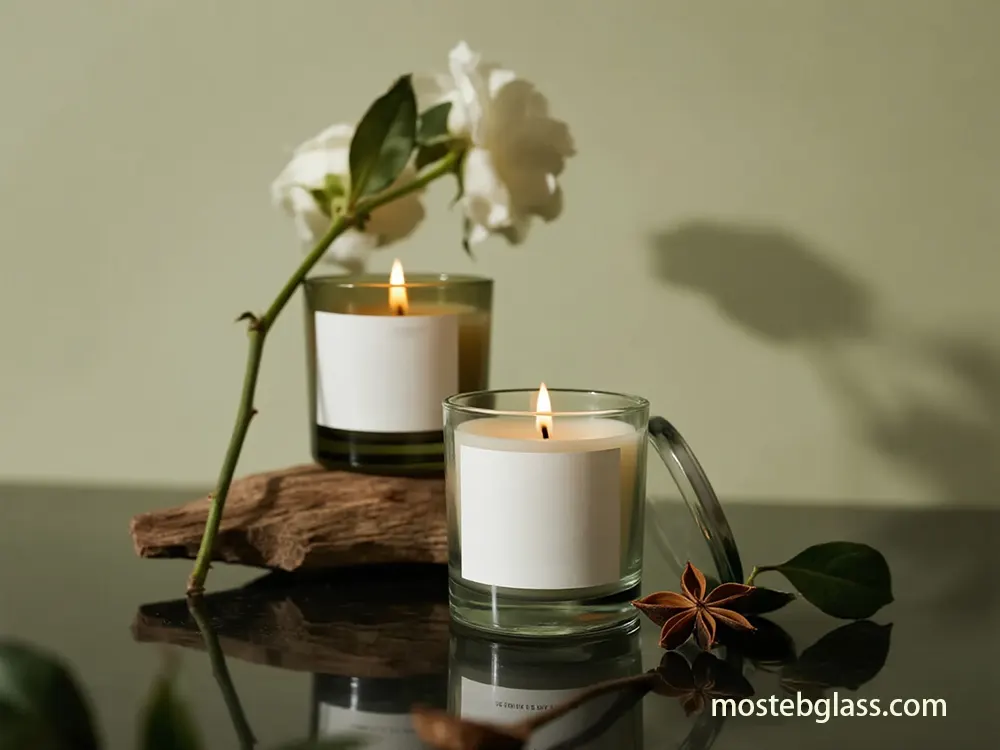
Modern glass manufacturing offers several techniques to craft different aesthetic identity and communicate specific brand characteristics: color coating, tinning, frosting, silkskrin printing, 3D printing, electroplating, hot stamping, water transfer printing, embossing, engging and iridescent glass craft.Rainbow glass combines luxury and sophistication, increasing the identity for high end products. Embossing combines the touch and visual dimensions, strengthening the brand identity.
3.8. Semiotics of Glass in Retail Guides Consumer Behavior
Semotics, study of signals, applies internally to internal marketing. Each visual element, including glass decoration, bears a conscious or subconscious meaning. The physical forms (signators) and concept (signed) of the glass combine to communicate messages. In-store design elements such as glass displays, layouts and atmosphere are carefully designed to direct consumer behavior and express the brand identity, which affects purchasing decisions.
3.9. Specialty Architectural Glass Creates Experiential Retail Environments
Decorative architectural glass replaces retail places with eye catching signs and immersive experiences. The trends include the “renewed retro-chic”, and back-lit for kinetic quality, color-shift dicroic glass (eg, bendhyheim’s optichrik®) using probability textured glass (eg, bendhyim’s Houdini ™), and back-shift for kinetic quality. They are align with experienced retail design.
3.10. "Liquid Glass" Design, Inspired by Digital Interfaces, Boosts Retail Engagement
Apple’s iOS 26 “liquid glass” design, with its fluid, affects translucent beauty, physical retail business. Consumer analytics showed an increase in 38% engagement with a glass-inspired display in premium retail, connecting to familiar digital interfaces. By 2025, 65% premium retail vendors are estimated to use fluid performance designs with translucent elements and multi-layer glass for dynamic visual depth.
3.11. Glass in Retail Design Offers Versatility for Dynamic Storytelling
Retailers use glass for versatile, flexible designs to keep fast layouts fresh and adapt to promotion. Laminated glass displays provide durability, flexibility and mobility for easy reconstruction. Switchable privacy glass, transparent to transparent infection, serves as a rear projection screen for multimedia, providing a versatile story stolen tool. Glass elements in the entrance create memorable visual effects.
3.12. Translating Abstract Brand Values into Tangible Glass Visuals
Tangible glass-based scenes require the brand story, desired feelings and defined to target customers to translate abstract brands. For example, the flareglass logo uses three stacked rectangles representing glass layers, which symbolizes durability, elegance and stability, mirring cut glass to express craftsmanship.
3.13. Nostalgia and Sensory Marketing Enhance Heritage Communication
Infecting the brand heritage in retail design can appeal to apathy and attach many senses. Nostalgia takes advantage of social engagement to encourage marketing expenses. Retail design can include fickle indifferent motifs, as seen in JUSTSO’s Moynat window display. Beyond scenes, sensory elements such as smell, texture, and music, combined with glass decoration, create immersive experiences promoting emotional shackles.
4. Sector-Specific Applications: Tailoring Glass Decor
Glass decor strategies differ in retail areas, each of which has designed to customize brand storytelling and display the impact for its specific audience and product range.
4.1. Luxury Fashion Retail: elegance, specificity and brand storytelling
In luxury fashion, the glass is a cornerstone, which is often combined for sophistication and specificity with polish metals and high quality forests. The design emphasizes minimalism, focusing on major pieces as unique treasures. Cases of glass display causes careful scattering, often showing some objects on pedestals or isolated within the glass. Use large glass aspects like Burberry.
4.2. Electronics Retail: Innovation, Interaction, and Futuristic Displays
Electronics stores take advantage of glass for interactive, futuristic product showcase. Switchable privacy glasses like advanced glass technologies, campaigner videos, interactive materials, or versatile multimedia displays for social media feeds. Add enthusiasm and innovation with a change in the optimum of glass. Video sharing, in-store and online shopping bridging.
4.3. Pop-Up Stores: Flexibility, Brand Communication, and Experiential Marketing
Pop-up shops prefer modular display solutions, often scratch-resistant clear acrylic (as a glass option), laminate, or flexible for metal slatwall, with quick assemblies for professional spaces, ie using slatewells. They are important for temporary merchandising, spontaneous brand communication and inviting. And sensitive goods, as seen in the mulberry showroom. The focus is on playful experiences, curated grains and agile constructions, often incorporating interactive elements such as touchscreen or virtual tri-on, such as Wave Clickwot’s digital food pairing display.
4.4. Cross-Sectoral Best Practices and Trends
Adaptability and scalability:
Modular glass display systems provide adaptability and scalability for quick re -recitation and adaptation in product lines and product lines. Glass performance provides durability, design flexibility and mobility to adapt to trends or promotion. Multi-brand environment, adaptable glass panel (through color, pattern, digital harmony)
Strategic lighting and transparency:
Strategic lighting in all retail is important to increase product appeal, draw attention and increase alleged price. Highlight the spotlights products. Glass transparency maximizes the product visibility and natural light, forms an invited environment and reduces the cost of energy. Glass glass in skylights can control the atmosphere, becoming opaque at night. For luxury, transparent entrances attract passers -by.
Consumer behavior and market trends:
A 2024 survey indicated that 71% of retail vendors believe that design is now more important, underlining new approaches.Including glass, retail performance, consumer affects the perception and buy decisions, attract attention, shape the product perception (eg, “hip and modern”), and stimulating the purchase of impulse. Immersive, interactive experience.
Material options: Glass vs. Acrylic:
Glass displays are attached to elegance, high-end retail, or future environment, crystal-clier visibility (up to 98% light transmission) and scratch resistance, ideal for premium items. Custom branding, with choice based on goals, use cases, and budget.
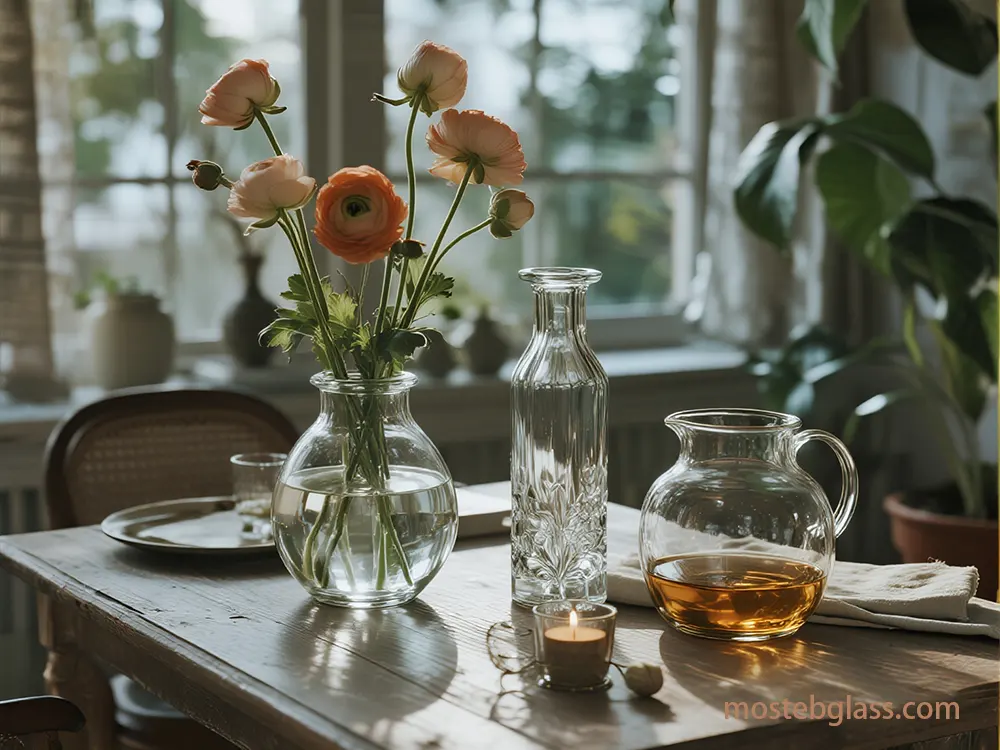
Safety and durability:
For high-value items, cases of glass displays are necessary for safety, often with locks. Glass scattering with glass provides resistance, breaking into pieces such as pebbles, increasing safety. Although the glass is scratch-resistant, acrylic provides greater effect durability, less brittleness.
5. Measuring Impact: Objectives, Engagement, and Outcomes
Integrating glass decor into retail displays is an investment aimed at enhancing brand perception and driving sales. Measuring impact requires a comprehensive approach using various metrics.
5.1. Key Performance Indicators (KPIs) for Retail Display ROI
Retail display measuring ROI involves tracking KPI beyond direct sales: incremental sales (ATVs), sales conversion rates, residence time (1% increase of 1% may increase sales), interaction rate and repeat engagement.
5.2. Advanced Analytics and Technology for Measuring Effectiveness
Advanced analytics (machine learning, predictive modeling, AI) provide deep insight into customer’s behavior, optimize operations and support data-operated decisions. Use technologies such as heat mapping to track customers and measure the delut, AI-operated cameras, motion sensors and RFIDs to measure del time and customer flow, and interactive elements (digital screws).
5.3. Visual Merchandising's Commercial Impact
Effective visual merchandising gives adequate business benefits. Increasing window performance can increase foot traffic by 23%, while sales from effective in-store displays can increase from 80% to 478%. It also enhances the image of the brand, improves customer experience (shopkeepers spend 20% more time in well -designed stores), and encourage repeat trips.
5.4. ROI Calculation for Retail Displays
The ROI for retail display compares the profit/profit to the cost. Sources include:
ROI
- Benefit −
- Cost or
- Net Profit/Cost A 2024 survey indicated that 71% of retail vendors believe that design is now more important, underlining new approaches.Including glass, retail performance, consumer affects the perception and buy decisions, attract attention, shape the product perception (eg, “hip and modern”), and stimulating the purchase of impulse. Immersive, interactive experience.
- ×KPIs like sales lift, ATV, and conversion rates quantify “benefit,” helping evaluate performance, justify spending, and optimize display design.
- 5.5. Challenges and Solutions for Isolating Glass Decor Impact It is challenging to distinguish the exact effect of glass decoration from other factors, careful experimental design and advanced analytics are required. Solutions include A/B testing (comparison of performing element versions against KPI), customer travel and emotion analysis (using AI Tools to track interaction and emotional engagement), and continuous monitoring (measuring effectiveness against previous periods).
5.6. Glass Display Cases and Perceived Value
Cases of glass display, especially the “additional vision” types, increase the visibility and offer a 360-degree viewing, highlight the craftsmanship for high-ticut items. The integrated LED lighting further carries out the details and creates an inviting environment, encouraging engagement.
6. Future Retail Storytelling: Integrating Advanced Technologies with Glass Decor
interactive, immersive, and evolving brand experiences. Mosteb actively explores these frontiers.
Smart glass for energy efficiency and dynamic retail:
Smart glass, using polymer-spread liquid crystals (PDLC) technology, controls sunlight, potentially reduces energy consumption by 30% by reducing artificial lighting and reducing dependence on HVAC. In retail, it converts storfronts into a breathtaking display, introducing a mixture of dynamic branding and openness/privacy. Glass glass consumes minimal power, an average of about 5 watts per 10 sq ft, which makes it durable.
Promoted reality for personal experiences (AR) smart glasses
:The smart glasses market is estimated to grow more than 2024-2029 to 29.4% CAGR, which is powered by AR, AI, and short. These devices enable the product view in 4K and 120Hz with micro-oleled displays, virtual tri-on, detailed product information, and customers’ spaces. This increases shopping, increases sales. Future designs include wireless, integrated chips, reducing smartphone dependence.
Projection mapping for immersive brand storytelling:
Projection mapping replaces any surface, which includes glass, immersive storytelling, product launch, and dynamic, interactive displays for promotion. Many commercial-grade HD projector, media server, and control boards, up to two days with setup.
Interactive retail promotes engagement and sales:=(Interactive displays (smart mirrors, holographic displays, AI-operated digital signage) can increase the customer’s busyness by 60% and increase sales up to 30% (Intel) or 40% for promoted items (hypervsN). $ 20.61 billion by 2028 (12.9% CAGR).Ethical Data Collection and Privacy:Retail increased for privatization requires strong data privacy morality using AI, IOT and AR. Retail vendors should ensure transparency about data collection, use, and sharing, following rules such as GDPR and ccpa.Key, objective boundaries, data minimalization, accuracy, and access to customer’s rights.)/Retail increased for privatization requires strong data privacy morality using AI, IOT and AR. Retail vendors should ensure transparency about data collection, use, and sharing, following rules such as GDPR and ccpa.Key, objective boundaries, data minimalization, accuracy, and access to customer’s rights. While advanced AR/VR can be expensive with limited ROI for small businesses, more cost-effective interactive solutions exist. Modular, customized display stand, which 65% of retailers plan to invest by 2025, offer flexibility, reducing life cycle costs. Important to maximize the ROI and navigate the volatility in the price of the material. Interactive retail promotes engagement and sales:=Beyond the current smart glass, Holographic displays are receiving traction to bring 3D product views in life. Researchers at Stanford developed 3 mm-rop holographic VR headset using A-Nhens Light Phase Control.7. Conclusion and RecommendationsGlass decor is a strategic property for retail brands that demand discrimination and deep consumer connections. Its versatility, beauty appeal, and technical integration make it indispensable to tell modern brand story. Taking advantage of innovative glass solutions, retail sellers can create an immersive, dynamic and memorable shopping experiences running business success.100
7.1. Strategic Recommendations for Retailers
7. Conclusion and Recommendations
Develop a signature glass architectural identity and protect it:
Commission unique, visually striking glass elements for flagship stores or chains (eg, custom facilities, sculpture installations). Mostb offered Bespok Solutions.
It creates immediate brand recognition and memorable physical appearance. Follow the designed patent and trademark for unique architectural features to install IP conservation, prevent replication and create a defensive market status.
Apply dynamic and interactive storefronts with smart glass:

Integrate switchable privacy glass in storefronts and key interior displays. Use transparency over the hours to show the products; After hours or for promotion, switch to opaque for multimedia content or high-language launch of interactive advertisements.
This storefront utility maximizes 24/7, converting the passive display into active marketing channels. This makes a “wow” factor, the growing foot traffic and brand recalls through dynamic visual engagement, while increasing the safety by obscuring the goods when closed.
- Curate experienced interiors with special ornamental and structural glass:Use various special glass types within the store. Planned to create a privacy area or to guide customer flows for the texture or frost-sedent glass (eg, fitting room with micro-fluated glass) for the partition. Include color-shift dacoic glass or sculpture elements for focal points, luxury and specific brand emotions.
- It increases in-store experience beyond transaction, promotes discovery and luxury. It creates a unique, aesthetic-rich environment that encourages long-term stay, enhances satisfaction, and confirms the notion of the brand as innovative and high-end.Give priority to stability and energy efficiency through advanced glass:
- Specify energy-efficient glass solutions (eg, low-E coatings, double/triple glazing) for all appropriate external and internal applications. Adapt the designs to maximize natural light.It significantly reduces operating costs through low energy consumption. It locates the brand environmentally responsible and durable, appealing to environment conscious consumers and enhances CSR credentials.
- Glass industry leaders associate innovative innovation:Actively participate actively with major glass manufacturers, facade engineers and industrial designers. Attach in co-construction projects to develop bespoke glass solutions to suit the needs and vision of the brand. Participate in industry events such as Glassstek for networking.
- It uses state -of -the -art technologies and expertise, leading to ownership, unique glass applications. This collaborative approach can result in a continuous pipeline of first-to-market solutions, shared R&D costs, and innovative retail design elements, which ensure continuous discrimination.7.2. Additional Research Directions
- To carry forward the further understanding of innovative glass solutions in retail design, the following research instructions are proposed:Role of intellectual property and design patent in unique glass decoration applications:
- comparative IP analysis of patent glass structures; Evaluation of design patents and trademarks; Check patent landscape for advanced smart glass features (sensors, AR, energy harvesting, self-cleaning); And research in global IP strategies for glass manufacturers/retailers.Capacity for collaborative innovation between glass manufacturers, designers and retailers:
to develop and evaluate framework for successful cooperation; Analyze the case study of groundbreaking glass solution from colleague R&D; Find out that advanced digital design tools (bim, generative design, VR prototypeing) facilitates cooperation; And research the primary incentives and obstacles for collaborative innovation in the glass-for-retail sector.
The possibility of future disruptive technologies or design paradigms that can further define the role of glass in retail:
check the future ability to close the close of AR/Holograffic technologies that directly embedded in retail glass surfaces (transparent OLED, Micro-LED); Find the progress in energy-cutting and self-sufficient glass aspects (photovoltaic, self-confidence/repair); Speculations on bio-decorated and responsible glass systems; Research the effects of advanced manufacturing (3D printing, robotic construction, AI-driven design) on customized glass forms; And guess how AI can personalize glass-based retail by dynamically adjusting real-time customer demographics or emotional reactions.
Wholesale Diffuser Bottles
Wholesale Glass Vases
- Data increases integrity, reduces manipulation risk, confirms stability claims, combat forgery. Leveraging Vintage Glass Ornaments for Potent Brand Storytelling
- 5.6. Importance of Emotional Connection and Storytelling in Marketing Comment
Submit your opinion
- Data increases integrity, reduces manipulation risk, confirms stability claims, combat forgery. Complete our quote request form or email us at
- 5.6. Importance of Emotional Connection and Storytelling in Marketing Select a product
glass candle jars
- Data increases integrity, reduces manipulation risk, confirms stability claims, combat forgery. glass vases
- 5.6. Importance of Emotional Connection and Storytelling in Marketing contact our Product Expert
Send us a message freely if you have any questions. We’ll get back to you within 30 minutes, and we’ll adhere to the
- Data increases integrity, reduces manipulation risk, confirms stability claims, combat forgery. full name
- 5.6. Importance of Emotional Connection and Storytelling in Marketing Please provide us with the capacity, shape, color, and quantity of the glass containers you require. Alsoplease feel free to share any other details or specific requirements to help us better understand yourproject.
Tell us your requirements, such as capacity, quantity, customization, etc.
- Data increases integrity, reduces manipulation risk, confirms stability claims, combat forgery. Actively participate actively with major glass manufacturers, facade engineers and industrial designers. Attach in co-construction projects to develop bespoke glass solutions to suit the needs and vision of the brand. Participate in industry events such as Glassstek for networking.
- 5.6. Importance of Emotional Connection and Storytelling in Marketing It uses state -of -the -art technologies and expertise, leading to ownership, unique glass applications. This collaborative approach can result in a continuous pipeline of first-to-market solutions, shared R&D costs, and innovative retail design elements, which ensure continuous discrimination.
7.2. Additional Research Directions
To carry forward the further understanding of innovative glass solutions in retail design, the following research instructions are proposed:
- Role of intellectual property and design patent in unique glass decoration applications: comparative IP analysis of patent glass structures; Evaluation of design patents and trademarks; Check patent landscape for advanced smart glass features (sensors, AR, energy harvesting, self-cleaning); And research in global IP strategies for glass manufacturers/retailers.
- Capacity for collaborative innovation between glass manufacturers, designers and retailers: to develop and evaluate framework for successful cooperation; Analyze the case study of groundbreaking glass solution from colleague R&D; Find out that advanced digital design tools (bim, generative design, VR prototypeing) facilitates cooperation; And research the primary incentives and obstacles for collaborative innovation in the glass-for-retail sector.
- The possibility of future disruptive technologies or design paradigms that can further define the role of glass in retail: check the future ability to close the close of AR/Holograffic technologies that directly embedded in retail glass surfaces (transparent OLED, Micro-LED); Find the progress in energy-cutting and self-sufficient glass aspects (photovoltaic, self-confidence/repair); Speculations on bio-decorated and responsible glass systems; Research the effects of advanced manufacturing (3D printing, robotic construction, AI-driven design) on customized glass forms; And guess how AI can personalize glass-based retail by dynamically adjusting real-time customer demographics or emotional reactions.
